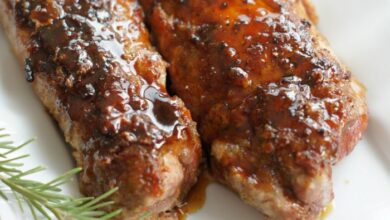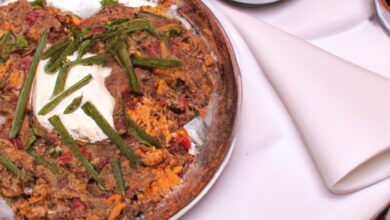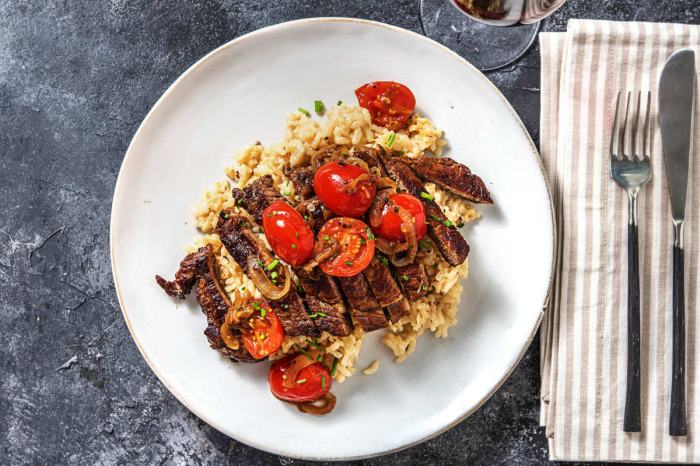
Rib Eye Steak and Mushroom Risotto: A Culinary Masterpiece
Rib eye steak and mushroom risotto – a combination that tantalizes taste buds and elevates any dining experience. The succulent, marbled rib eye, perfectly seared and juicy, meets the creamy, earthy richness of mushroom risotto, creating a symphony of flavors.
This culinary pairing is a testament to the art of cooking, where each element complements and enhances the other, leaving you with a truly unforgettable meal.
From the selection of the finest rib eye cut to the careful preparation of the risotto, every step in this culinary journey demands attention and precision. We’ll delve into the secrets behind achieving the perfect rib eye, exploring different cuts, dry-aging techniques, and ideal cooking methods.
Then, we’ll embark on a journey into the world of mushroom risotto, uncovering its history, exploring various mushroom varieties, and mastering the art of creating a creamy, flavorful masterpiece. Finally, we’ll discover how to pair these culinary stars, considering wine pairings, complementary side dishes, and optimal cooking times for a harmonious dining experience.
The Rib Eye Steak
The rib eye steak, a cut of beef prized for its rich flavor and tender texture, is a culinary masterpiece that deserves a place of honor on any discerning palate. Its succulent qualities stem from its unique characteristics, making it a favorite among steak enthusiasts worldwide.
Characteristics of a High-Quality Rib Eye Steak
A high-quality rib eye steak is distinguished by its marbling, tenderness, and flavor. Marbling, the intramuscular fat dispersed throughout the muscle, contributes significantly to the steak’s juiciness and flavor. The more marbling a rib eye has, the richer and more flavorful it will be.
Tenderness is another key characteristic, achieved through the inherent muscle structure of the rib section and the presence of marbling. The fat acts as a natural lubricant, resulting in a melt-in-your-mouth experience. Lastly, the flavor of a rib eye steak is a symphony of savory notes, enhanced by the marbling and the natural sweetness of the beef.
Cuts of Rib Eye Steak
Rib eye steaks are available in various cuts, each with its own unique characteristics in terms of size, fat content, and ideal cooking methods.
A perfectly cooked rib eye steak with creamy mushroom risotto is a meal that always hits the spot. But sometimes, you want something lighter and a little bit different. That’s where the grilled asparagus steak bundles come in. They’re a great way to add a touch of spring to your plate, and the combination of tender steak and crisp asparagus is truly delicious.
Of course, you can’t go wrong with a classic rib eye and risotto, but these bundles offer a fresh and exciting alternative.
- Bone-in Rib Eye:This classic cut includes the rib bone, which adds flavor and visual appeal. It’s typically larger and thicker than boneless cuts, making it ideal for slow cooking methods like roasting or grilling over low heat.
- Boneless Rib Eye:This cut offers a more convenient option, as it’s easier to handle and cook. It’s usually smaller and thinner than bone-in cuts, making it suitable for pan-searing, grilling, or broiling.
- Ribeye Cap:This premium cut, also known as the “tomahawk steak,” features a long bone with a thick layer of fat. It’s renowned for its exceptional marbling and tenderness, making it perfect for grilling or roasting.
Dry-Aging Rib Eye Steak at Home
Dry-aging is a process that involves storing meat in a controlled environment to enhance its flavor and tenderness. While it’s typically done commercially, you can also dry-age a rib eye steak at home.
A perfectly seared rib eye steak, juicy and flavorful, is a culinary masterpiece. But even the most exquisite steak needs a companion worthy of its presence. For me, that companion is often a creamy mushroom risotto, its earthy flavors complementing the richness of the meat.
And to round out the meal, a touch of sweetness is always welcome. That’s where a classic homemade banana pudding with whipped cream topping comes in, its creamy texture and comforting sweetness a perfect counterpoint to the savory notes of the steak and risotto.
- Select a High-Quality Rib Eye:Choose a well-marbled rib eye steak with a good fat cap.
- Prepare the Steak:Trim any excess fat and pat the steak dry with paper towels.
- Create a Dry-Aging Environment:Find a cool, dry place with good airflow. A refrigerator with adjustable humidity levels is ideal.
- Wrap the Steak:Wrap the steak in butcher paper or cheesecloth to allow for airflow and prevent mold growth.
- Age the Steak:Dry-age the steak for 10-21 days at a temperature between 34°F and 38°F (1°C and 3°C) and a humidity level of 70-80%.
- Monitor and Adjust:Regularly check the steak for mold growth and adjust the humidity level as needed.
- Prepare for Cooking:Once the steak is dry-aged, trim off any mold and pat it dry. It’s ready to be cooked to your liking.
Mushroom Risotto
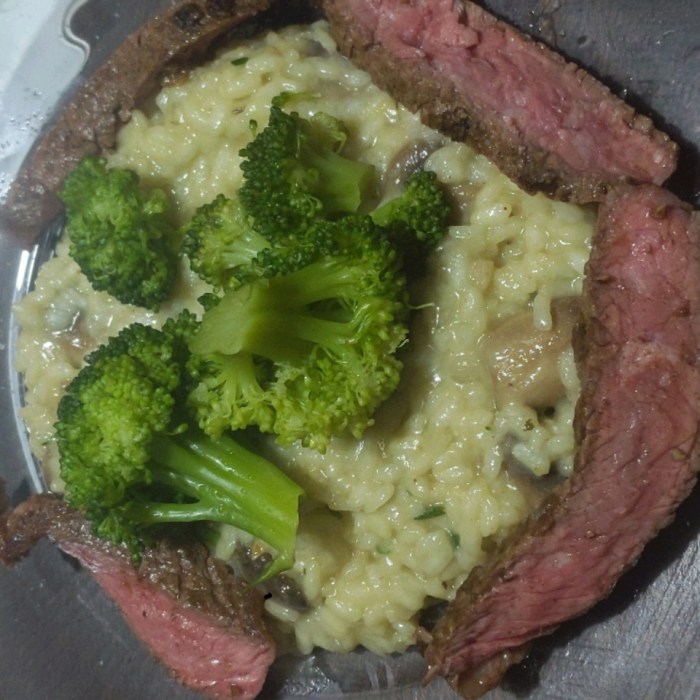
Risotto, a creamy and comforting Italian rice dish, is a culinary masterpiece that has captured hearts and palates worldwide. Its origins can be traced back to the Lombardy region of Italy, where it was traditionally prepared using Arborio rice, a short-grain variety known for its starchiness.
A juicy rib eye steak with creamy mushroom risotto is a classic combination, but sometimes you crave something different. If you’re looking for a unique appetizer to pair with your meal, consider trying khachapuri georgian cheese bread , a cheesy, bread-based delight from Georgia.
It’s a wonderful contrast to the richness of the steak and risotto, providing a lighter, tangy note to your culinary adventure.
This starchiness is crucial for achieving the characteristic creamy texture of risotto.
The History and Origins of Risotto
Risotto’s history is intertwined with the history of rice cultivation in Italy. Rice was introduced to Italy in the 15th century, and it quickly became a staple food in the Po Valley, particularly in Lombardy. The region’s fertile soil and abundance of water provided ideal conditions for rice cultivation.
Over time, the people of Lombardy developed unique ways to prepare rice, and risotto emerged as a culinary expression of their ingenuity.The traditional method of preparing risotto involves slowly cooking Arborio rice in broth, adding it gradually and stirring constantly to release the starch and create a creamy consistency.
This technique, known as “risotto alla Milanese,” involves adding saffron, a spice that imparts a vibrant yellow color and a distinctive aroma.
Mushrooms Best Suited for Risotto
Mushrooms are a natural pairing for risotto, adding depth of flavor and an earthy aroma. A variety of mushrooms can be used, each offering a unique flavor profile and texture.
- Porcini Mushrooms:These wild mushrooms, known for their intense, earthy flavor, are highly prized in Italian cuisine. Their rich aroma and meaty texture elevate the risotto to new heights.
- Cremini Mushrooms:Also known as baby bellas, these mushrooms offer a milder, more delicate flavor than porcini mushrooms. They are readily available and provide a versatile option for risotto.
- Shiitake Mushrooms:These Asian mushrooms have a distinctive umami flavor and a slightly chewy texture. They add a unique dimension to risotto, making it both savory and complex.
- Chanterelles:These brightly colored mushrooms possess a fruity, slightly peppery flavor. They add a touch of sweetness and a vibrant aroma to risotto.
A Step-by-Step Guide to Creating Classic Mushroom Risotto
Creating a classic mushroom risotto is a culinary journey that requires patience and attention to detail. The key to a successful risotto lies in the gradual addition of broth and constant stirring. This process allows the rice to absorb the liquid slowly, releasing its starch and creating a creamy texture.
Step 1: Prepare the Mushrooms
Clean the mushrooms thoroughly, removing any dirt or debris. Slice them into thin pieces or leave them whole, depending on your preference. Sauté the mushrooms in olive oil over medium heat until they are softened and golden brown.
Step 2: Cook the Rice
In a separate pot, heat olive oil over medium heat. Add the Arborio rice and cook for a few minutes, stirring constantly, until the rice becomes translucent.
Step 3: Add the Broth
Gradually add the hot broth to the rice, one ladleful at a time, stirring constantly. The broth should be absorbed by the rice before adding more.
Step 4: Incorporate the Mushrooms
Once the rice has absorbed most of the broth, add the sautéed mushrooms to the pot. Stir gently to combine the flavors.
Step 5: Season and Serve
Season the risotto with salt, pepper, and grated Parmesan cheese to taste. Stir gently to distribute the flavors evenly. Serve the risotto immediately, garnished with additional Parmesan cheese and fresh herbs.
Tip:For a richer flavor, add a splash of white wine to the risotto during the cooking process.
Pairing the Steak and Risotto: Rib Eye Steak And Mushroom Risotto
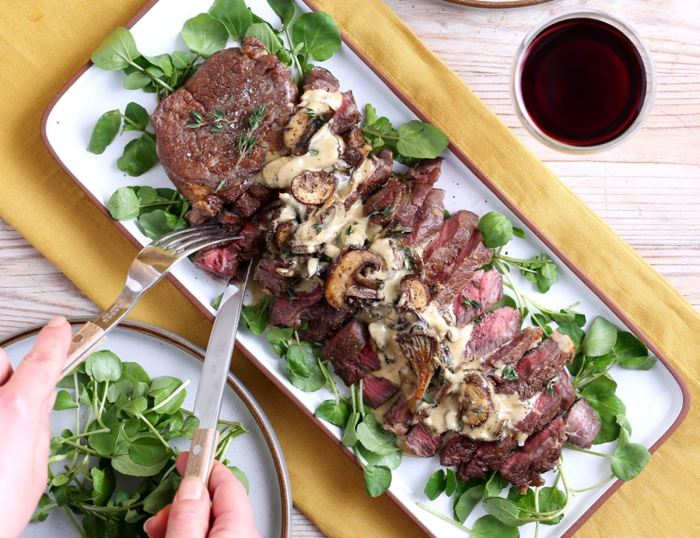
A rib eye steak and mushroom risotto is a classic pairing for a reason: the rich, savory flavors of the steak complement the earthy, creamy risotto perfectly. However, there are many ways to elevate this dish even further by considering the right wine pairing and complementary side dishes.
Wine Pairings
Wine pairings for rib eye steak and mushroom risotto should consider the richness of the steak and the earthy, creamy notes of the risotto. A full-bodied red wine with notes of fruit and spice is a classic choice, but there are other options that can enhance the flavors of the dish.
- Cabernet Sauvignon: This bold red wine has notes of black currant, cedar, and vanilla that pair well with the richness of the steak. Its tannins can also stand up to the creaminess of the risotto.
- Zinfandel: This California-style red wine offers notes of jammy fruit, spice, and pepper, making it a perfect match for the steak’s savory flavors. Its lighter tannins are a good match for the creamy risotto.
- Pinot Noir: For a lighter and more elegant pairing, Pinot Noir offers notes of cherry, earth, and spice that complement the mushroom risotto while not overpowering the steak.
Side Dishes, Rib eye steak and mushroom risotto
Complementary side dishes can enhance the overall dining experience by adding contrasting textures and flavors to the steak and risotto.
| Side Dish | Description |
|---|---|
| Roasted Asparagus | The bitterness of asparagus contrasts with the richness of the steak and risotto. |
| Creamed Spinach | The creamy texture and subtle flavor of creamed spinach complement the risotto and add a touch of elegance. |
| Grilled Mushrooms | Grilled mushrooms add an extra layer of earthy flavor to the dish. |
| Roasted Root Vegetables | Roasted root vegetables, such as carrots, parsnips, and potatoes, provide a sweet and savory counterpoint to the steak and risotto. |
Cooking Times and Temperatures
To ensure a harmonious meal, the steak and risotto should be cooked to optimal timing and temperature.
| Dish | Cooking Time | Cooking Temperature |
|---|---|---|
| Rib Eye Steak (1-inch thick) | 4-5 minutes per side for medium-rare | 400°F (204°C) |
| Mushroom Risotto | 20-25 minutes | 180°F (82°C) |
Enhancing the Experience

A delicious meal is about more than just the flavors; it’s about the entire experience. Creating a visually appealing presentation and a delightful dining ambiance elevates the simple act of eating into an unforgettable culinary adventure.
Plating Techniques
The way you present your food can dramatically impact how it’s perceived. Plating your rib eye steak and mushroom risotto involves creating a harmonious visual composition that complements the flavors and textures of the dish.
- Steak Placement:Position the steak strategically on the plate, either centered or slightly off-center, depending on the overall design. Consider creating a visual flow by angling the steak slightly.
- Risotto Arrangement:The risotto can be placed alongside the steak, creating a classic juxtaposition. Alternatively, you can create a more modern presentation by placing a generous dollop of risotto in the center of the plate and arranging the steak around it.
- Adding Height:Using a small ramekin or bowl, elevate the risotto slightly for a more dynamic presentation. This adds dimension and visual interest to the plate.
- Garnishes:Use fresh herbs like rosemary or thyme, or a sprinkle of grated parmesan cheese for a finishing touch. A sprig of parsley or a few edible flowers can also add a pop of color and visual appeal.
- Sauce Drizzle:A drizzle of pan sauce or a reduction of red wine can add a touch of elegance and enhance the visual appeal. The sauce can be drizzled around the steak or across the risotto.
Dining Setting Ambiance
The ambiance of your dining setting can significantly impact your dining experience. Here are some tips to create a visually appealing and inviting atmosphere:
- Lighting:Soft, warm lighting creates a cozy and romantic atmosphere. Dim the overhead lights and use candles or lamps to create a warm glow.
- Table Decor:Use a simple tablecloth in a neutral color, such as white or cream. Add a centerpiece that complements the meal, such as a vase of fresh flowers or a bowl of fruit. Avoid clutter and keep the table decor minimal.
- Music:Choose music that complements the ambiance you’re trying to create. Soft classical music or jazz can create a sophisticated atmosphere, while a playlist of your favorite songs can create a more casual and relaxed vibe.
Creating a Simple Table Setting
A well-set table can elevate any meal. Here’s a step-by-step guide to creating a simple yet elegant table setting:
- Tablecloth:Start with a clean tablecloth in a neutral color like white or cream.
- Placemats:If desired, add placemats for a touch of texture and visual interest. Choose placemats that complement the tablecloth.
- Dinner Plates:Place dinner plates in the center of each place setting. Choose plates that are simple and elegant, in a color that complements the tablecloth.
- Salad Plates:Place salad plates to the left of the dinner plates.
- Flatware:Place the fork to the left of the dinner plate and the knife to the right, with the blade facing the plate. The spoon, if needed, can be placed to the right of the knife.
- Glassware:Place a water glass to the right of the knife, and a wine glass above the knife.
- Napkins:Place napkins to the left of the forks, either folded or rolled.
- Centerpiece:Add a centerpiece to the center of the table, such as a vase of flowers or a bowl of fruit.

